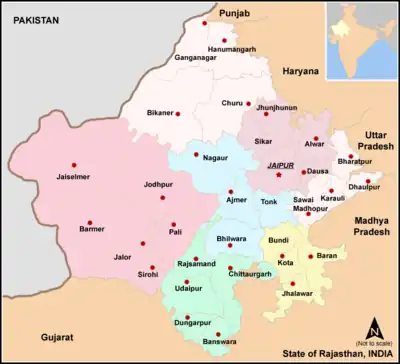| Historical Region of North India Jangal Desh | |
 | |
| Location | northern Rajasthan |
Jangladesh, also known as Janglu, was a historical region in north, north-western and north-eastern Rajasthan state in northern India.[1][2][3] It included the present-day districts of Bikaner, Churu, Ganganagar, and Hanumangarh. It was bounded on the south by Marwar and Jaisalmer regions, on the east by Ajmer-Merwara region.[4]
History
The north-eastern and north-western part of Rajasthan, was known by the name of Jangladesh in ancient times. The northern and western part of Jangladesh was ruled by the Bhatis while the north-east and south east was in the control of Jat settlements. The Bhatner area was under the Muslim Bhattis and Johiyas.[5][6][7]
Most of Jat clans in Jangladesh had to accept Rathore suzerainty due to Rao Bika's invasion of Jangladesh. Bika led an army of 300 Rajput warriors and subjugated all of the Jat clans of northern Rajasthan. Bika also saved the Jats from the Bhati Rajputs and acted as their buffer. The Godara Jats, Sevad Rajpurohits and Charans were loyal supporters of Bika.[8][4] The population of this region is 8,147,344 as of the 2011 census.
See also
References
- ↑ Qanungo, Kalika Ranjan; Kānūnago, Kālikā Rañjana (1960). Studies in Rajput History. S. Chand. p. 60.
whereas the Jats lived in the Jangal-desh (a portion of ancient Kuru-Jangal region), which covers Bikanir and some portion of the Jodhpur State.
- ↑ Singh, Karni (1974). The Relations of the House of Bikaner with the Central Powers, 1465-1949. Munshiram Manoharlal Publishers. p. 12. ISBN 978-0-8364-0457-9.
"The old name of the territories which went to constitute the Rathore principality of Bikaner, had been 'Jangal Desh'.
{{cite book}}: CS1 maint: date and year (link) - ↑ Hooja, Rima (2006). A History of Rajasthan. Rupa & Company. p. 6. ISBN 978-81-291-0890-6.
In a different context, a part of the desert land now part of the administrative division of Bikaner was apparently known as 'Jangal' (also 'Jangal-desh).
{{cite book}}: CS1 maint: date and year (link) - 1 2 Jibraeil (2006). "Position of Jats in Churu Region". In Singh, Vir (ed.). Jats: Their Role and Contribution to the Socio-Economic Life and Polity of North and North-West India. Vol. 2 (1st ed.). Originals. p. 223. ISBN 978-81-88629-51-0.
- ↑ Hooja, Rima (2006). A History of Rajasthan. Rupa & Company. p. 385. ISBN 978-81-291-0890-6.
the Bhatis who controlled the territories to the north and west while to the east, north-east and south east were the settlements of different Jat clans...around this renowned Bhatner were the settlements of the chiefly muslim Bhattis, Johiyas and others.
{{cite book}}: CS1 maint: date and year (link) - ↑ Jibraeil (2006). "Position of Jats in Churu Region". In Singh, Vir (ed.). Jats: Their Role and Contribution to the Socio-Economic Life and Polity of North and North-West India. Vol. 2 (1st ed.). Originals. pp. 221–223. ISBN 978-81-88629-51-0.
- ↑ Sharma, Dasharatha (1966). Rajasthan Through the Ages: From the earliest times to 1316 A.D. Bikaner. pp. 287–288.
There is good reason to believe that parts of the present north-eastern and north-western Rajasthan were inhabited by Jat clans ruled by their own chiefs and largely governed by their own customary law.
{{cite book}}: CS1 maint: date and year (link) CS1 maint: location missing publisher (link) - ↑ Kothiyal, Tanuja (2016). Nomadic Narratives: A History of Mobility and Identity in the Great Indian. Cambridge University Press. p. 78. ISBN 9781107080317. Retrieved 17 September 2020.